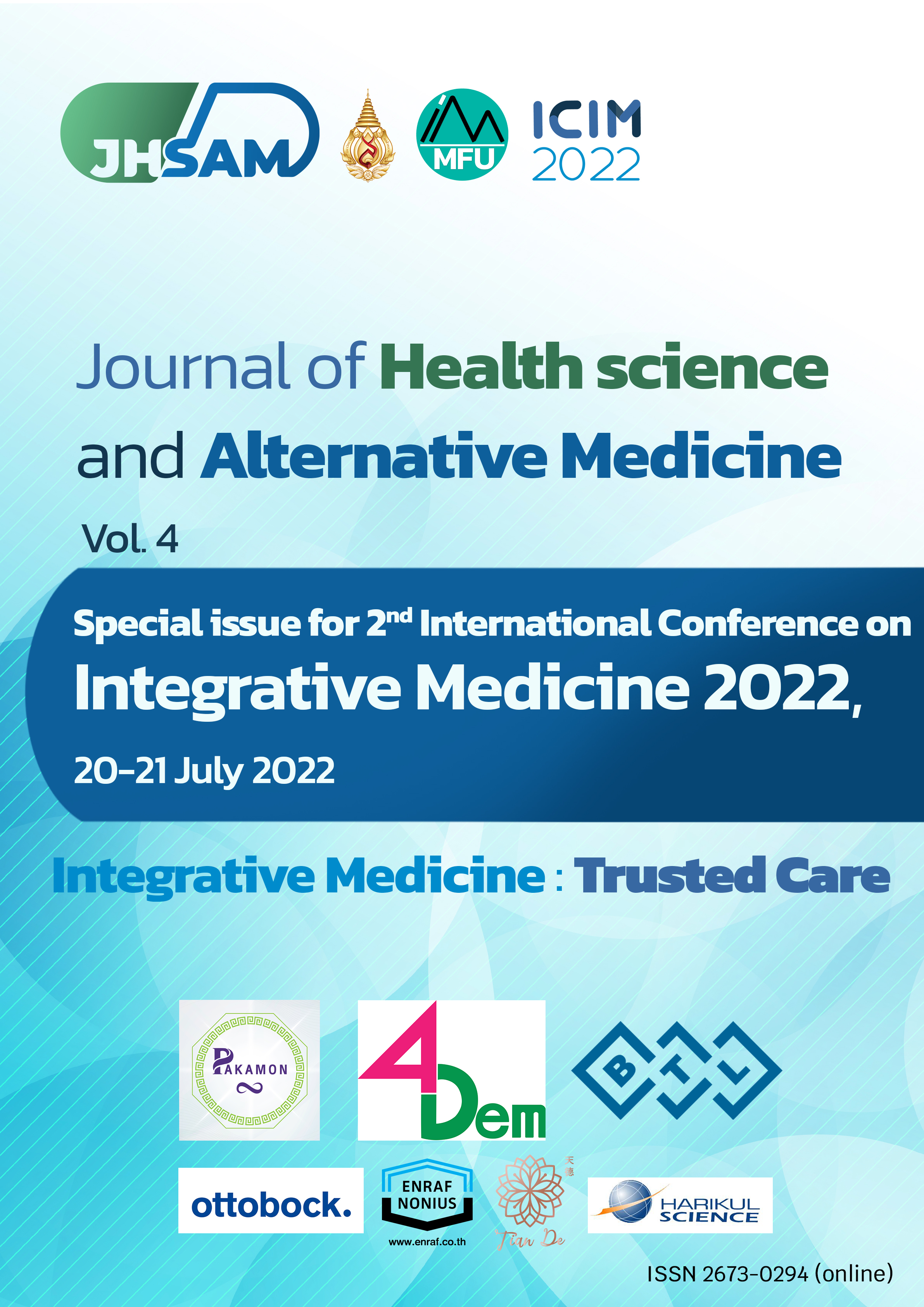C18. Correlation between Perceived Severity of COVID-19 and Self-Protective Behavior during COVID-19 Pandemic in Chiang Rai Smokers
Main Article Content
Abstract
Introduction: The COVID-19 disease affects among economy, society, and health in population. Smoking could increase chance of contracting COVID-19 and increase the severity level of COVID-19 symptom. No study about the impact of COVID-19, perceived severity of COVID-19 and smoking behavior in smoking population during COVID-19 pandemic in Chiang Rai.
Objective: There are three aims of this study which are to study smoking behavior, to study impact of the Covid-19 pandemic situation in Chiang Rai smokers and to study the correlation between perceived severity of COVID-19 and self-protection behavior during the COVID-19 pandemic in Chiang Rai smokers.
Methods: The smokers have smoke at least 3 years, aged 18-60 years old and stayed in Chiang Rai were recruited in this study. A self-administered anonymous questionnaire was used to collect information via google form program. The questionnaires comprising 5 parts consisted of sociodemographic data, smoking behavior, impact of smoker on the covid-19 situation, perceived severity of covid-19 and protective behavior from covid-19.
Results: 215 smokes were recruited in this study. The most participants are 200 (93.0%) males, mean aged 33.03 (±12.38) years old. Mean duration of smoking is 15.11 (±11.98). Smoking behavior, they usually buy cigarettes from retail stores, 1 time a week, each time bought a pack of cigarettes, an average cost of 61-80 bath a time and average monthly cost of 101-500 baht. COVID-19 impact to income and expense of smokers. The protection yourself by wearing a mask, wash your hands with soap or alcohol gel and keeping distance in Chiang Rai did not affect the smoking behavior and the purchase of cigarettes among the smoking population in Chiang Rai. The correlation between perceived severity of COVID-19 and self-protective behavior from COVID-19 is 0.166 (p-value = 0.015).
Conclusion: There is not impact of the COVID-19 pandemic on smoking and the vigilant measures against the spread of covid-19 excepted economy. Poor correlation between perceived severity of COVID-19 and self-protective behavior from COVID-19.
Article Details

This work is licensed under a Creative Commons Attribution-NonCommercial-NoDerivatives 4.0 International License.
JHSAM publishes all articles in full open access, meaning unlimited use and reuse of articles with appropriate credit to the authors.
All our articles are published under a Creative Commons "CC-BY-NC-ND 4.0". License which permits use, distribution and reproduction in any medium,
provided that the original work is properly cited and is used for noncommercial purposes.
References
World Health Organization, (2021), WHO Coronavirus (COVID-19) Dashboard. Retrieved 6 October 2021, from https://covid19.who.int/
Centers of Disease Control and Prevention. (2020). “Lung Cancer.” Retrieved 15 September 2021, from https://www.cdc.gov/cancer/lung/basic_info/risk_factors.htm
กรมควบคุมโรค. กระทรวงสาธารณสุข. (2564). โรคติดเชื้อไวรัสโคโรนา 2019 (COVID-19). สืบค้นเมื่อ 6 กันยายน 2564. จาก https://ddc.moph.go.th/viralpneumonia/
Sutus J. and Chanagul C. (2021). Factors affecting decision on smoking after Coronavirus (COVID-19) spread case study of the higher risk group in Bangkok. Journal of Buddhist Education and Research, 7,1(84).
ศิริวรรณ พิทยรังสฤษฏ์, ปวีณา ปั้นกระจ่าง. (2561). รายงานสถิติการบริโภคยาสูบของประเทศไทย พ.ศ. 2561. ศูนย์ติดตามสถานการณ์การระบาดของเชื้อไวรัสโคโรนาสายพันธุ์ใหม่ 2019 ของจังหวัดเชียงราย. (พิมพ์ครั้งที่ 1) กรุงเทพมหานคร: เจริญดีมั่นคงการพิมพ์.
พรพินันท์ ยี่รงค์. (2563). ผลกระทบจากการเเพร่ระบาดของไวรัสโควิด-19 ต่อเศรษฐกิจ เชียงราย ด้านการค้าชายแดนและการท่องเที่ยว
เสาวลักษม์ กิตติประภัสร์ และคณะ. (2563). ผลกระทบทางสังคมจากการระบาดของเชื้อไวรัสโคโรนา 2019 (COVID-19) และวิกฤตเศรษฐกิจ. มหาวิทยาลัยรังสิต.
Somnuk Sakunhongsophon. (2020). Tobacco control research and knowledge management center. TCR research updated, 2(13).
Hooda Waehayi. (2020). Severity perception and preventive behavior on the Coronavirus disease -2019 among youth at Sateng-Nok Subdistrict, Muang District, Yala Province. Academic Journal of Community Public Health, 6(4).
Vardavas CI, Nikitara K. (2020). COVID-19 and smoking: A systematic review of the evidence. Tobacco induced diseases,18(20).
Chan, Y. H. (2003). Biostatistics 104: correlational analysis. Singapore Med J, 44(12), 614-619.
Prapaporn Ruksuk. (2018). Smoking behavior of people in Surat Thani province. (dissertation). Songkla: Prince of Songkla University.
Chakkrit Sela, Mongkol Ratcha, Anu Surach, Saroj Nakju, Suradej Samranjit. New normal lifestyles in prevention of COVID–19 pandemic among people in Bangkok. (2021). Journal of Sakon Nakhon Hospital, 24(2).
Supattra Rungrut, Sulfikor Maso, Yutthana Kadem. (2021). The economic and social impacts from the covid-19 pandemic toward the people in Yala city municipality Yala province. Journal of Social Science and Buddhistic Anthropology, 6(2).
Chen-Sankey, J. C., Broun, A., Duarte, D. A., Ajith, A., Jewett, B., Smiley, S. L., Mead-Morse, E. L., Guy, M. C., & Choi, K. (2020). Exploring changes in cigar smoking patterns and motivations to quit cigars among black young adults in the time of COVID-19. Addictive behaviors reports, 12, 100317.
Gendall, P., Hoek, J., Stanley, J., Jenkins, M., & Every-Palmer, S. (2021). Changes in Tobacco Use During the 2020 COVID-19 Lockdown in New Zealand. Nicotine & tobacco research: official journal of the Society for Research on Nicotine and Tobacco, 23(5), 866–871.
กรมควบคุมโรค. (2564). กระทรวงสาธารณสุข: แนวทางปฏิบัติเพื่อการป้องกันโรคติดเชื้อไวรัสโคโรนา 2019 (COVID-19) หรือโควิด 19 สำหรับประชาชนทั่วไปและกลุ่มเสี่ยง (ฉบับวันที่ 3 มกราคม 2564)
Burachat Jandaeng, Saowaluk Kosolkittiamporn, Sanya Kenaphoom (2019). Factors that affecting behavior change. Dhammathas Academic Journal, 19(4).

